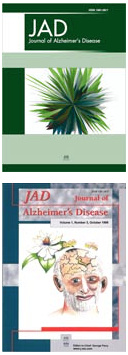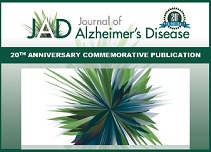- Academic Source Complete
- Biological Abstracts
- BIOSIS Previews
- CAB Abstracts
- CAB Health
- Chemical Abstracts Service (CAS)
- CSA Biological Sciences
- CSA Illumina
- CSA Illustrata Natural Sciences
- CSA Neurosciences Abstracts
- e-psyche database
- EBSCO database
- Embase
- EMCare
- Index Copernicus
- Index Medicus
- Journal Citation Reports/Science Edition
- MEDLINE
- Prous Science Integrity
- PsycInfo
- PubMed
- PubsHub
- Science Citation Index Expanded (SciSearch)
- Scopus
- Ulrich's Periodicals Directory
2022: Jan | Feb | Mar | Apr | May | Jun | Jul | Aug | Sep | Oct | Nov | Dec
2021: Jan | Feb | Mar | Apr | May | Jun | Jul | Aug | Sep | Oct | Nov | Dec
2020: Jan | Feb | Mar | Apr | May | Jun | Jul | Aug | Sep | Oct | Nov | Dec
 During 2018, JAD celebrates its 20th anniversary and we invite you to view the special message (here) about the journal's 20 years from Editor-in-Chief George Perry. An open access celebratory issue was published as JAD 62:3. View the content at: tiny.cc/JAD-anniv. The anniversary issue pays tribute to those who have contributed to JAD and then, we look forward to what lies in store to the next years of AD research, in our new book Alzheimer's Disease: New Beginnings. We also published a special commemorative publication that can be viewed online here (PDF).
During 2018, JAD celebrates its 20th anniversary and we invite you to view the special message (here) about the journal's 20 years from Editor-in-Chief George Perry. An open access celebratory issue was published as JAD 62:3. View the content at: tiny.cc/JAD-anniv. The anniversary issue pays tribute to those who have contributed to JAD and then, we look forward to what lies in store to the next years of AD research, in our new book Alzheimer's Disease: New Beginnings. We also published a special commemorative publication that can be viewed online here (PDF).
Our Cover
 For the current cover (2004–present), JAD editors chose Casey Reas, an artist and educator exploring abstract kinetic systems through diverse digital media including software, animation, and digital prints. Casey's cover for JAD was generated from software written specifically for the journal. It generates thousands of flower-like images and from these many variations, Casey selected the cover image. The chosen form and color are a reference to the magnolia flower of Darryl Evan’s cover illustration (1999–2003) of Hippocrates, where the flying pieces of the Alzheimer's puzzle and steel magnolia symbolize the one out of the sixteen Americans who stand behind each Alzheimer's victim. And so with this motif, the two covers, past and present, link and illustrate the continuance in JAD's mission to deliver top-quality science.
For the current cover (2004–present), JAD editors chose Casey Reas, an artist and educator exploring abstract kinetic systems through diverse digital media including software, animation, and digital prints. Casey's cover for JAD was generated from software written specifically for the journal. It generates thousands of flower-like images and from these many variations, Casey selected the cover image. The chosen form and color are a reference to the magnolia flower of Darryl Evan’s cover illustration (1999–2003) of Hippocrates, where the flying pieces of the Alzheimer's puzzle and steel magnolia symbolize the one out of the sixteen Americans who stand behind each Alzheimer's victim. And so with this motif, the two covers, past and present, link and illustrate the continuance in JAD's mission to deliver top-quality science.
Book Series
The book series "Advances in Alzheimer's Disease" brings together the latest insights in Alzheimer’s disease research in specific areas in which major advances have been made. It assembles and builds on work recently published in JAD, and also includes further contributions to ensure comprehensive coverage of the topic. The emphasis is on the development of novel approaches to understanding and treating Alzheimer’s and related diseases. Find out more at: tiny.cc/AIAD. The latest volume, Alzheimer's Disease and Air Pollution, is available here.
The Publisher






